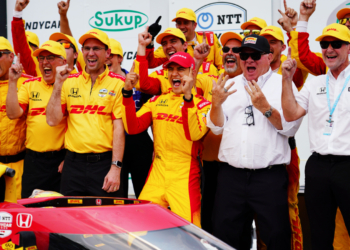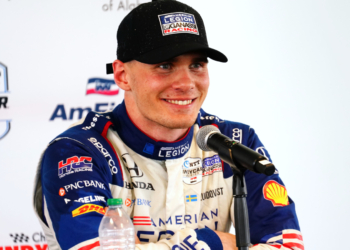Formula 1 launches back into action at Albert Park, Melbourne this weekend for the traditional Australian Grand Prix curtain-raiser. Motorsport Week provides the key information.
History
Australia joined the Formula 1 World Championship in 1985 at a circuit designed around the streets of Adelaide, and its installation as the season finale led to some iconic moments. Nigel Mansell famously suffered a tyre blow-out in 1986, costing him a chance to clinch the title, while eight years later Michael Schumacher and Damon Hill came to blows, a result which secured the 1994 crown for the German, his first of seven.
The event switched from Adelaide to Melbourne to 1996 with the leafy Albert Park the venue, and the circuit immediately became a favourite among drivers. Its status as the first round of the campaign – an honour it has held on all bar two occasions – has resulted in some dramatic starts to new seasons, and a few unexpected results.
Circuit

The layout of the Albert Park circuit, formed on parkland roads around a man-made lake, has remained fundamentally unchanged across its 22-year history. It features a mixture of slow, medium and high-speed sections, while good traction and strong driveability over kerbs is required, and the brakes also receive a fair workout. The semi-permanent nature of the circuit, allied to its infrequent use, means grip is often at a premium, particularly in the early stages of the weekend. The walls are close, leaving little room for error, while several gravel traps also line the circuit to catch out those who risk too much.
“The Albert Park track is quite old school,” comments Force India’s Esteban Ocon.
“It’s narrow and very technical. The secret to a good lap is being neat and tidy because it’s largely made up of low and medium-speed corners. I would say the most exciting part of the lap is the high-speed chicane through Turns 11 and 12 because it’s easy to make a mistake and lose time.”
“It’s got the feeling of being a street circuit, but it has the flow of a permanent road course,” adds Haas’ Kevin Magnussen, who scored his sole podium to date on his Formula 1 debut at the event in 2014.
“It’s tricky because it’s bumpy in places, braking zones are twisty, and corners are tight in places. That said, it still has some good, high-speed sections like Turn 11. The chicane there is really, really fast with the current-generation car. It’s just exciting to be in Australia. It’s the first race of the year and that brings a special feeling.”
Renault’s Nico Hulkenberg explains: “Sector two is probably my favourite part, just after Turns 3 and 4, as there is a quick right-hander, narrow on the exit and no run-off area, then the following right-hander is also bumpy on entry, underneath trees, with some nice kerbs. It’s a great track to race with some fast sections even though it’s a street course.”
The prime overtaking opportunities on a track where passing can be tricky are typically into the respective right-handers at Turn 1 or Turn 3 – the latter the scene of several enormous accidents over the years, most recently Fernando Alonso’s spectacular roll in 2016.
Another right-hander at Turn 13 also provides a passing chance, though the pursuant needs to stay close to a rival through the aforementioned fast chicane at Turn 11/12 – which is far from easy.
What happened in 2017?

Sebastian Vettel cast aside memories of Ferrari’s win-less 2016 campaign by beating Mercedes rival Lewis Hamilton to victory, having extended his first stint on Ultrasoft tyres, with the Briton’s prospects dented further by getting stuck behind the yet-to-stop Max Verstappen.
Vettel ultimately pulled clear after the pit stop phase to win by almost 10 seconds, as Hamilton held off new Mercedes team-mate Valtteri Bottas, while Kimi Raikkonen took fourth.
Vettel’s victory was his second Australian Grand Prix triumph (adding to his 2011 success), as he joined fellow two-time winners Hamilton (2008, 2015) and Raikkonen (2007, 2013).
Alonso is the only other current driver to have savoured success Down Under, claiming top spot with Renault in 2006.
Hamilton’s pair of wins does not match up to his qualifying record at the circuit: he has taken pole position on six occasions, and has not been beaten over one lap at Albert Park in the hybrid era.
In addition to his current streak (2014-17), Hamilton claimed pole in 2008 and 2012; Vettel (2010, 2011, 2013) and Raikkonen (2007) are the other drivers on the current grid to have claimed the accolade.
Other details
Tyre supplier Pirelli has nominated the Ultrasoft (purple), Supersoft (red) and Soft (yellow) compounds for this weekend’s Grand Prix.
As per the regulations, from each driver’s 13 sets of tyres, one batch of Ultrasofts must be allocated for use only in Q3, while either the Supersoft or Soft must be run during the course of the 58-lap race, should dry conditions prevail.
There will, in a tweak, be three DRS zones. The original two from recent years have been retained, and they are located along the pit straight and between Turns 2 and 3 – controlled by a single detection point, situated on the entry to Turn 14.
A new section of DRS usage has been added on the exit of Turn 12, through to Turn 13, with a detection point 170 metres before the fast left-hander at Turn 11.
Weather forecast:

Friday: Sunny spells, 29°c
Saturday: Risk of thundery showers, 26°c
Sunday: Light rain, 22°c
Timetable: (GMT+11)
Friday 23 March
FP1: 12:00 – 13:30
FP2: 16:00 – 17:30
Saturday 24 March
FP3: 14:00 – 15:00
Qualifying: 17:00 – 18:00
Sunday 25 March
Race: 16:10 (58 laps/two hours)
Any milestones?

As ever, the start of the new campaign is a new chapter, and two drivers are poised to make their Formula 1 debuts this weekend: Williams’ Sergey Sirotkin and Sauber’s Charles Leclerc.
Sirotkin will become the third Russian to race in Formula 1, after Vitaly Petrov and Daniil Kvyat, while Leclerc will be the fourth Monegasque to achieve the feat.
Conversely, following the exit of Felipe Massa, it will be the first time since the 1971 Dutch Grand Prix that no Brazilian driver has been entered for a Grand Prix.
Meanwhile, it is the first Grand Prix for the team-engine partnerships at McLaren (Renault) and Toro Rosso (Honda) respectively, following their off-season swap.
What next?
Bahrain will host the second round of the season from April 6 to 8






